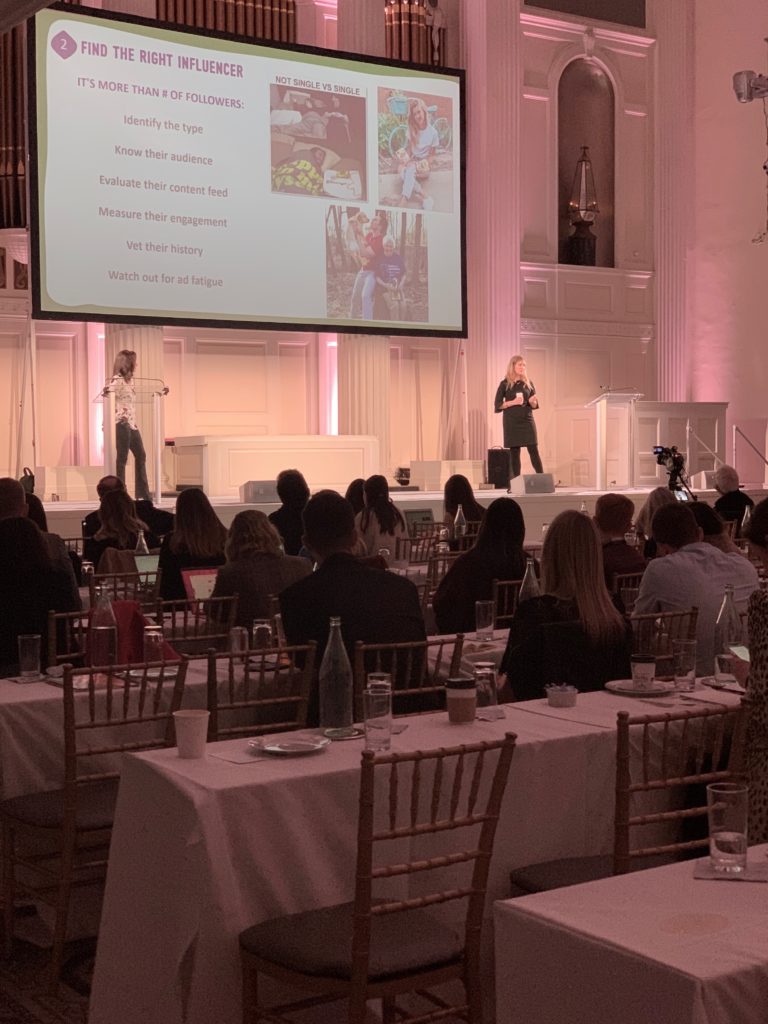Influencer marketing is an exploding area of marketing and is expected to be a $10 billion industry in 2020, growing to $15 billion by 2022. Why is it so fast growing? Because influencers actually influence sales. According to Nielson, 92 percent of consumers trust influencer marketing over traditional advertising. Influencers have the authority and trust with their audience to influence their behaviors.
To understand more about how to successfully utilize influencers for our clients, I headed to the first annual Association of National Advertisers (ANA) Influencer Marketing Conference in NYC in late November. During the jam-packed two-day event we heard from influencer marketing experts from companies like Jet Blue, Frito-Lay, SAP, Volvo, Clorox, and more.
I’ll share several takeaways from the conference but first things first:
What exactly is an influencer?
An influencer is a trusted voice who influences buyer decisions through an established social media following.
Influencers are typically categorized based on their audience size.
-
- Nano-influencer — Under 5,000 followers
- Micro- influencer— 5,000- 100,000 followers
- Macro-influencer – 100,000- 500,000 followers
- Mega-influencer— 500,000 to 5 million followers
- Celebrity— 5+ million
Influencers are typically younger. Nine out of 10 the sponsored posts in 2018 were from people age 34 and under.
An influencer doesn’t even have to be human. There are pet influencers, like Doug the Pug with more than 6 million followers, and even CGI (computer generated influencers) like Lilmiquela with 1.8 million Instagram followers. Read more on CGI influencers here—it’s fascinating.
Best Practices for Influencer Marketing
- Invest in long-term partnerships, not one-offs.
Influencer marketing is not a quick, short-term thing. Brands need to think holistically and consider it an “always-on” part of the marketing mix. Aim for 6-month or 12-month contracts with an influencer rather than a one-off promotion, which with the speed of social media, will fall off the grid within days. A travel influencer who spoke at the conference, Oneika Raymond, said it wisely, “When you invest in influencers, they will invest in you. - Be selective.
Focus on quality over quantity when selecting influencers. Tools such as Traackr can help you identify potential influencers, but then reach out via DM to set up a time to chat. If all goes well, meet them in person because they might be different in real life than what they portray online. Keep in mind that the influencer is vetting you just as much as you are vetting them. - Build relationships.
Once you’ve found a good fit, continue the relationship with ongoing events, dinners, etc. It’s important to build trust and transparency with influencers and foster a mutually beneficial relationship. If influencers are truly excited to work with the brand, it will show. A solid relationship will also come in handy to have open conversations if any issues arise. - Give influencers autonomy.
Leave room at the creative table for your influencer. Brands have a tendency to overbrand and give overly prescriptive requirements. E.g. For every single Instagram story, a brand wants a “Swipe Up” and 5 different tags and hashtags. This is where influencer marketing becomes artificial and inorganic. Allow influencers to use their own voice because they know their audience best. Empower them to tell your story through their lens. Trust is still the #1 quality consumers look for in social media influencers, so don’t jeopardize that by turning it into a canned sales pitch. Bottom line – let them be themselves. - Go beyond the influencer’s audience.
Take the influencer-produced content and re-purpose it through paid media, email, your website, display ads, etc., to reach beyond the influencer’s fan base. Linqia, an influencer marketing platform, found that influencer content outperformed typical brand content with a 2.7x better CTR. - Not just a B2C game.
Influencer marketing in the B2B space is still in its infancy, but influencers are just as important for B2B companies as they are for B2C businesses. SAP’s Head of Influencer Marketing Ursula Ringham spoke at the conference about their robust B2B influencer program. They utilize thought leaders, like Data Scientist Ronald van Loon who has more than 200,000 Twitter followers, for tradeshows, podcasts, blog posts and more. - Don’t go it alone.
It takes a village to incorporate an influencer marketing program. Cross collaboration between many different teams— including social, PR, digital, events, customer service, and agency partners— is key to bringing a program to fruition. Don’t be siloed. Everyone needs to work together to make it happen. - Vary the types of content.
Influencer marketing is not just limited to a social media post. Utilize the many forms of content marketing available, such as blog posts, video, live streams, podcasts and infographics— especially in B2B marketing.Important note: Influencer marketing can have big results, but there are also many risks and hurdles to navigate. More on that here.
-
Do your due diligence.
Quite often, influencers get vetted by the youngest person on the team. But when you buy an influencer, you buy the whole package. So if the influencer is found to display misogyny, hate speech, criminal or inappropriate activity, it can do damage to your brand. A prominent example of this is Logan Paul, one of the wealthiest YouTube stars who had 20 million followers and a billion views. He posted a video of an apparent suicide victim in late 2017 and faced tremendous backlash and loss of sponsors.Potential influencers should be thoroughly vetted, including their past postings, old accounts and less popular platforms, in search of any red flags. They should also be evaluated for fake followers. Many influencers have succumbed to buying followers in hopes of appealing to larger brands. There are online tools available that can help determine the authenticity of an influencer’s following, but any tool needs to be augmented by review from real people.
-
Clearly disclose the partnership.
According to the FTC, influencers must always disclose they are marketing a product. E.g. “Thanks to X brand for the free product.” These disclosures must be clear and not buried at the end of the post, in their profile, or in a string of hashtags. One of the simplest ways brands and influencers can disclose the partnership is by using the hashtag #ad at the beginning of the post. While the term “ad” is deemed OK, the FTC doesn’t accept abbreviations that aren’t immediately clear such as #spon or #collab. Facebook and Instagram’s built-in disclosure tools also do not comply, as they can be easily missed. All parties, including the agency, brand and influencer have a duty to comply. The FTC recently came out with a fun, new guide and video that explains influencer compliance in laymen’s terms, which you can view here. -
Keep it to the facts.
Another FTC rule to keep in mind is that anything an influencer says needs to be true and factual. Influencers shouldn’t say anything about your product or brand that you can’t say yourself. For example, they can’t claim a product treats a medical condition. Opinions are safe, such as, “It’s the best ketchup I’ve ever tried.” - Dot your I’s and cross your T’s.
To mitigate several influencer risks, brands should develop influencer agreements, which is a legal document that outlines the terms of the relationship. An influencer agreement should include:
- Content creation— Number of posts, videos, etc the influencer is expected to create during a specific timeframe.
- Approval guidelines— How much control the brand will receive in approving content. While brands usually want as much approval as possible, influencers also want to be authentic. Be very clear about the dont’s, but then give influencers the autonomy to create content in their own voice.
- Ownership— Who owns the content, how you can use the influencer content, and for how long.
- Exclusivity— Ensure influencers aren’t talking about your competitors the next month.
- Payment Structure
- FTC disclosure compliance
- Authenticity of following
- Morals Clause— Right to terminate the contract if an influencer is involved in offensive activity before or during the duration of the contract.

Influencer marketing is a growing and exciting strategy to engage with new audiences, cut through the noise, and get a high ROI. It’s word of mouth marketing on steroids. As with any new media channel, there will be both challenges and opportunities. Marketers can start small to test and learn, while remembering the most important thing about influencer marketing— trust.
For more information on our experience and learnings at the ANA Influencer Marketing Summit, contact me (Amanda Pollard) directly at apollard@tellyourstoryinc.com.

